|
|
Post by Steve Gardner on Jun 11, 2008 20:48:10 GMT
Source: NASAA Fire Rainbow Over New Jersey
Credit & Copyright: Paul Gitto (Arcturus Observatory) Explanation: What is that inverted rainbow in the sky? Sometimes known as a fire rainbow for its flame-like appearance, a circumhorizon arc is created by ice, not fire. For a circumhorizon arc to be visible, the Sun must be at least 58 degrees high in a sky where cirrus clouds are present. Furthermore, the numerous, flat, hexagonal ice-crystals that compose the cirrus cloud must be aligned horizontally to properly refract sunlight like a single gigantic prism. Therefore, circumhorizon arcs are quite unusual to see. Pictured above, however, a rare fire rainbow was captured above trees in Whiting, New Jersey, USA in late May. |
|
|
|
Post by Steve Gardner on Jun 11, 2008 20:50:39 GMT
Source: NASADextre Robot at Work on the Space Station
Credit: STS-124 Crew, Expedition 17 Crew, NASA Explanation: What's the world's most complex space robot doing up there? Last week, Dextre was imaged moving atop the Destiny Laboratory Module of the International Space Station (ISS), completing tasks prior to the deployment of Japan's Kibo pressurized science laboratory. Dextre, short for the Canadian-built Special Purpose Dextrous Manipulator, has arms three meters in length and can attach power tools as fingers. Behind Dextre is the blackness of space, while Earth looms over Dextre's head. The Kibo laboratory segment being deployed during space shuttle Discovery's trip to the ISS can be pressurized and contains racks of scientific experiment that will be used to explore many things, including how plants brace themselves against gravity, and how water might be inhibited from freezing in cells under microgravity. |
|
|
|
Post by Jack on Jun 12, 2008 16:36:08 GMT
Source: NASA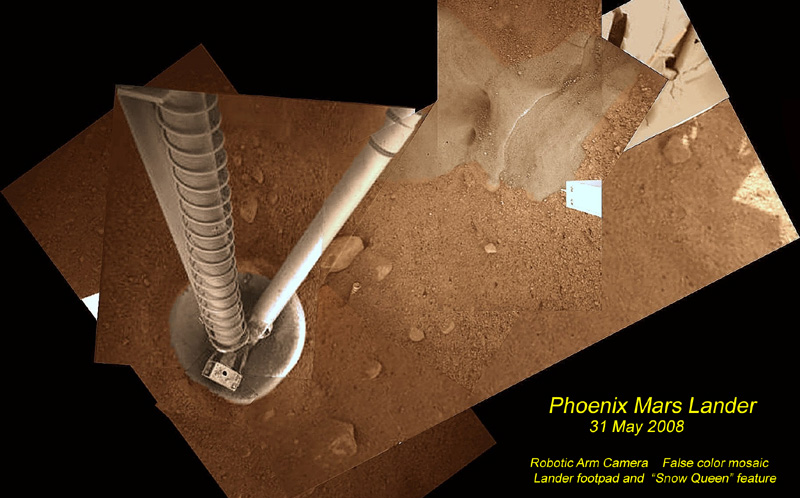 Phoenix and the Snow Queen Phoenix and the Snow Queen
Credit: Kenneth Kremer, Marco Di Lorenzo, Phoenix Mission, NASA, JPL, UA,
Max Planck Inst., Aviation Week and Space Technology
Explanation: A flat, smooth, shiny feature dubbed the Snow Queen is near the top of this color mosaic of the surface beneath the Phoenix Mars Lander. Recorded with the lander's robotic arm camera as it was maneuvered to look under the lander, the region also includes a leg and plate-sized footpad. An intriguing detail near the footpad at about the 2 o'clock position, is a metal spring partially buried in martian soil, a piece of the arm's now opened biobarrier. The smooth Snow Queen feature is strongly suspected to be ice originally just under the soil, uncovered by the thruster rockets as Phoenix set down on the north polar plains of Mars. In fact, the apparent holes or depressions in the Snow Queen's otherwise flat surface are located just under the thrusters.
|
|
|
|
Post by Jack on Jun 14, 2008 10:41:58 GMT
Source: NASA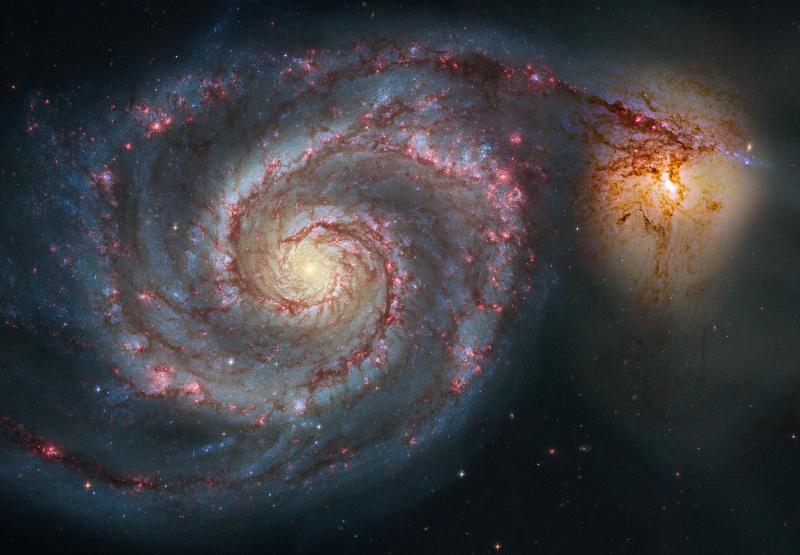 M51 Hubble Remix M51 Hubble Remix
Credit: S. Beckwith (STScI), Hubble Heritage Team, (STScI/AURA), ESA, NASA
Additional Processing: Robert Gendler Explanation: The 51st entry in Charles Messier's famous catalog is perhaps the original spiral nebula - a large galaxy with a well defined spiral structure also cataloged as NGC 5194. Over 60,000 light-years across, M51's spiral arms and dust lanes clearly sweep in front of its companion galaxy (right), NGC 5195. Image data from the Hubble's Advanced Camera for Surveys has been reprocessed to produce this alternative portrait of the well-known interacting galaxy pair. The processing has further sharpened details and enhanced color and contrast in otherwise faint areas, bringing out dust lanes and extended streams that cross the small companion, along with features in the surroundings and core of M51 itself. The pair are about 31 million light-years distant. Not far on the sky from the handle of the Big Dipper, they officially lie within the boundaries of the small constellation Canes Venatici.
|
|
|
|
Post by Jack on Jun 15, 2008 11:03:19 GMT
Source: NASA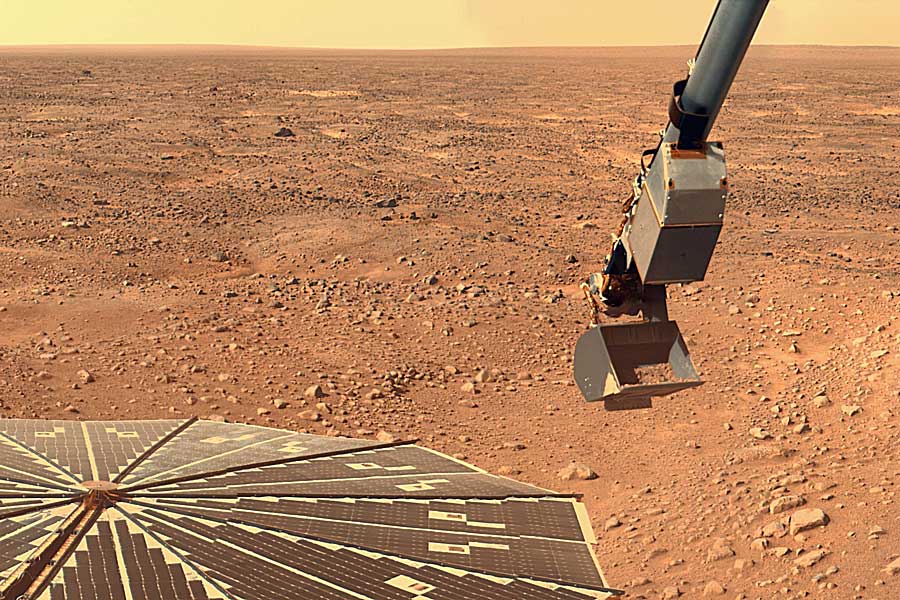 Phoenix Digs for Clues on Mars Phoenix Digs for Clues on Mars
Credit: Phoenix Mission Team, NASA, JPL-Caltech, U. Arizona, Texas A&M University
Explanation: What's a good recipe for preparing Martian soil? Start by filling your robot's scoop a bit less than half way. Next, dump your Martian soil into one of your TEGA ovens, being sure to watch out for clumping. Then, slowly increase the temperature to over 1000 degrees Celsius over several days. Keep checking to see when your soil becomes vaporized. Finally, your Martian soil is not ready for eating, but rather sniffing The above technique is being used by the Phoenix Lander that arrived on Mars three weeks ago. Data from the first batch of baked soil should be available in a few days. Pictured above, a circular array of the Phoenix Lander's solar panels are visible on the left, while a scoop partly filled with Martian soil is visible on the right. The robotic Phoenix Lander will spend much of the next three months digging, scooping, baking, sniffing, zapping, dissolving, and magnifying bits of Mars to help neighboring Earthlings learn more about the hydrologic and biologic possibilities of the sometimes mysterious red planet.
|
|
|
|
Post by Jack on Jun 21, 2008 10:20:35 GMT
Source: NASA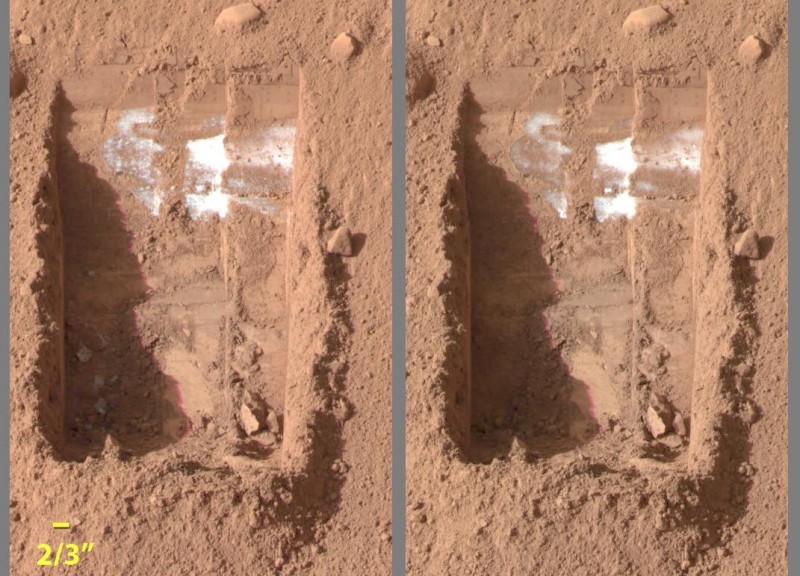 Vanishing Act Vanishing Act
Phoenix Mission Team, NASA, JPL-Caltech, U. Arizona, Texas A&M UniversityExplanation: Compare these two close-up pictures taken on sol 20 (left) and sol 24 of a trench dug in the Martian surface by NASA's Phoenix Lander. Those sols of the Phoenix Mission (a sol is a Martian day), correspond to June 15 and 18 on planet Earth. Light-colored, dice-sized chunks, visible in the lower left shadow region of the trench in the sol 20 image have vanished by sol 24 -- a strong indication that the chunks were ice uncovered by digging the shallow trench. The vanishing act likely demonstrates the sublimation of ice in the trench, a process similar to evaporation, in which the ice went directly from solid to gas after it was exposed to sunlight and the thin, dry Martian atmosphere.
|
|
|
|
Post by Jack on Jun 27, 2008 15:04:57 GMT
Source: NASA M81: Feeding a Black Hole M81: Feeding a Black Hole
Credit: X-ray: NASA/CXC/Wisconsin/D.Pooley & CfA/A.Zezas;
Optical: NASA/ESA/CfA/A.Zezas; UV: NASA/JPL-Caltech/CfA/J.Huchra et al.; IR: NASA/JPL-Caltech/CfAExplanation: This impressive color composite shows spiral galaxy M81 across the electromagnetic spectrum. It combines X-ray data (blue) from the Chandra Observatory, infrared data (pink) from the Spitzer Space Telescope, and an ultraviolet image (purple) from the GALEX satellite, with a visible light (green) Hubble image. The inset highlights X-rays from some of M81's black holes, including black holes in binary star systems with about 10 times the mass of the sun, as well as the central, supermassive black hole of over 70 million solar masses. Comparing computer models of the giant black hole's energy output to the multiwavelength data suggests that feeding that monster is relatively simple -- energy and radiation is generated as material in the central region swirls inwards forming an accretion disk. In fact, the process otherwise appears to be just like the accretion process feeding M81's stellar mass black holes, even though the central black hole is millions of times more massive. M81 itself is about 70,000 light-years across and only 12 million light-years away in the northern constellation Ursa Major.
|
|
|
|
Post by Jack on Jun 28, 2008 11:46:09 GMT
Source: NASA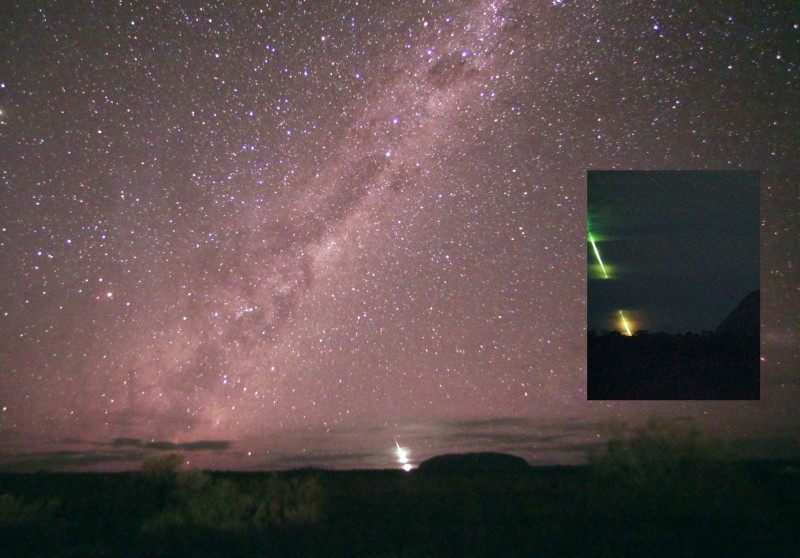 Fireball at Ayers Rock Fireball at Ayers Rock
Credit & Copyright: Joseph BrimacombeExplanation: A weekend trip for astrophotography in central Australia can result in gorgeous skyscapes. In this example recorded in March of 2006, the center of our Milky Way Galaxy rises over planet Earth's horizon and the large sandstone formation called Uluru, also known as Ayers Rock. After setting up two cameras to automatically image this celestial scene in a series of exposures, one through a wide-angle and the other through a telephoto lens, photographer Joseph Brimacombe briefly turned his back to set up other equipment. To his surprise, the ground around him suddenly lit up with the brilliant flash of a fireball meteor. To his delight, both cameras captured the bright meteor streak. Highlighted in the telephoto view (inset), the fireball trail shines through cloud banks, just left of Ayers Rock.
|
|
|
|
Post by Jack on Jul 1, 2008 19:53:33 GMT
Source: NASA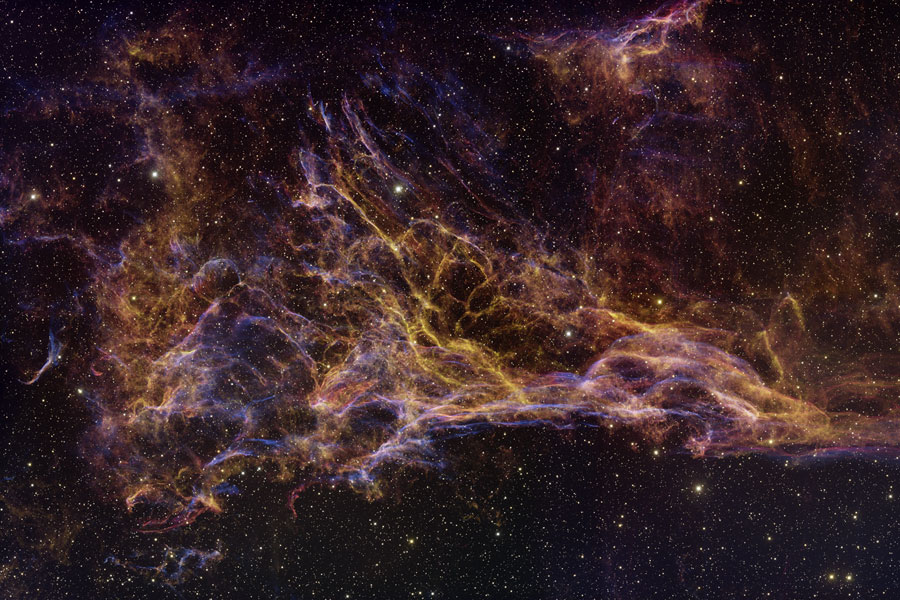 Pickering's Triangle from Kitt Peak Pickering's Triangle from Kitt Peak
Credit & Copyright: T. Rector (U. Alaska Anchorage), H. Schweiker, WIYN, NOAO, AURA, NSFExplanation: Wisps like this are all that remain visible of a Milky Way star. About 7,500 years ago that star exploded in a supernova leaving the Veil Nebula, also known as the Cygnus Loop. At the time, the expanding cloud was likely as bright as a crescent Moon, remaining visible for weeks to people living at the dawn of recorded history. Today, the resulting supernova remnant has faded and is now visible only through a small telescope directed toward the constellation of Cygnus. The remaining Veil Nebula is physically huge, however, and even though it lies about 1,400 light-years distant, it covers over five times the size of the full Moon. In images of the complete Veil Nebula, studious readers should be able to identify the Pickering's Triangle component pictured above, a component named for a famous astronomer and the wisp's approximate shape. The above image is a mosaic from the 4-meter Mayall telescope at the Kitt Peak National Observatory located in Arizona, USA.
|
|
|
|
Post by Jack on Jul 2, 2008 17:06:16 GMT
Source: NASA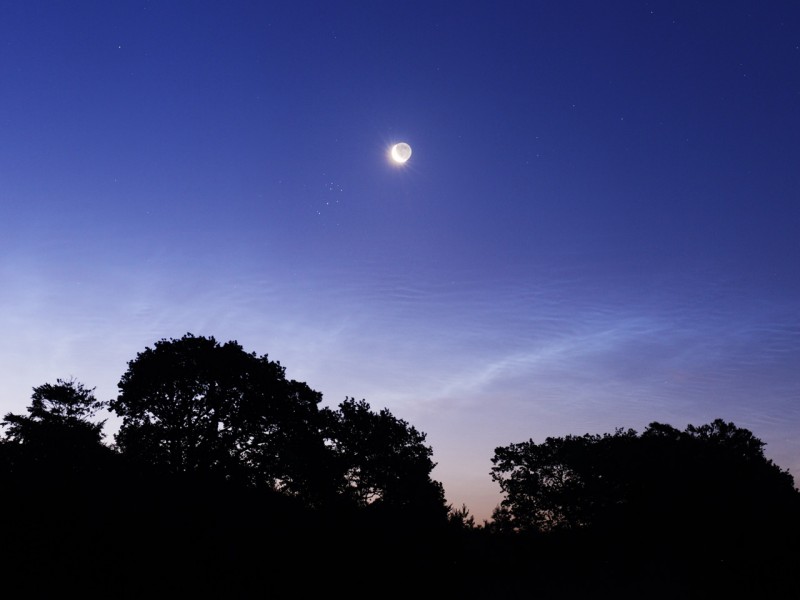 Night Shinings Night Shinings
Credit & Copyright: Laurent Laveder (PixHeaven.net / TWAN) Explanation: In the early morning hours of June 30th, ghostly clouds hovered in the east in this view of near dawn skies over western France. The noctilucent or night-shining clouds lie near the edge of space, reflecting sunlight from about 80 kilometers above Earth's surface. Usually spotted above the poles in summer, they are now seen with increasing frequency farther from the poles, in this case extending to the photographer's latitude of about 48 degrees north. The trend could be a telltale sign of global changes in the atmosphere. Another 400,000 kilometers away, the Moon's sunlit crescent shines brightly, its night side illuminated by Earthshine. Of course, as a bonus for early risers June's old crescent Moon was followed closely across the sky by the lovely Pleiades star cluster, surrounded by cosmic dust clouds and shining from a mere 400 light-years away.
|
|
|
|
Post by Jack on Jul 3, 2008 17:16:13 GMT
Source: NASA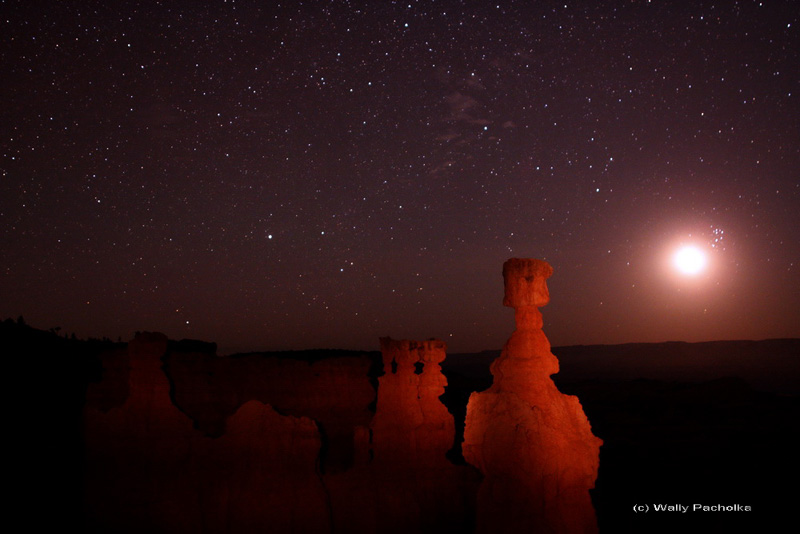 Hoodoo Sky Hoodoo Sky
Credit & Copyright: Wally Pacholka (Astropics.com / TWAN) Explanation: The strange-looking rock formations in the foreground of this skyscape are called hoodoos. Towers of weathered, eroded sedimentary rock, hoodoos are found in arid regions of planet Earth and are particularly abundant in an area known as Bryce Canyon National Park in southern Utah, USA. The more familiar night sky pictured here was recorded early Monday morning and includes bright star Capella, alpha star of the constellation Auriga, left of center. On the far right, a very over exposed crescent Moon dominates the sky in close conjunction with the sister stars of the Pleiades cluster. The curious shapes of the two tall, illuminated hoodoos suggest their popular monikers; Thor's Hammer (right) and The Temple of Osiris.
|
|
|
|
Post by Jack on Jul 4, 2008 7:55:34 GMT
Source: NASA SN 1006 Supernova Remnant SN 1006 Supernova Remnant
Credit: X-ray - NASA/CXC/Rutgers/G.Cassam-Chenai, J.Hughes et al.; Radio - NRAO/AUI/NSF/GBT/VLA/
Dyer, Maddalena & Cornwell; Optical - Middlebury College/F.Winkler, NOAO/AURA/NSF/CTIO Schmidt & DSS Explanation: A new star, likely the brightest supernova in recorded human history, lit up planet Earth's sky in the year 1006 AD. The expanding debris cloud from the stellar explosion, found in the southerly constellation of Lupus, still puts on a cosmic light show across the electromagnetic spectrum. In fact, this composite view includes X-ray data in blue from the Chandra Observatory, optical data in yellowish hues, and radio image data in red. Now known as the SN 1006 supernova remnant, the debris cloud appears to be about 60 light-years across and is understood to represent the remains of a white dwarf star. Part of a binary star system, the compact white dwarf gradually captured material from its companion star. The buildup in mass finally triggered a thermonuclear explosion that destroyed the dwarf star. Because the distance to the supernova remnant is about 7,000 light-years, that explosion actually happened 7,000 years before the light reached Earth in 1006. Shockwaves in the remnant accelerate particles to extreme energies and are thought to be a source of the mysterious cosmic rays.
|
|
|
|
Post by Jack on Jul 8, 2008 15:49:24 GMT
Source: NASA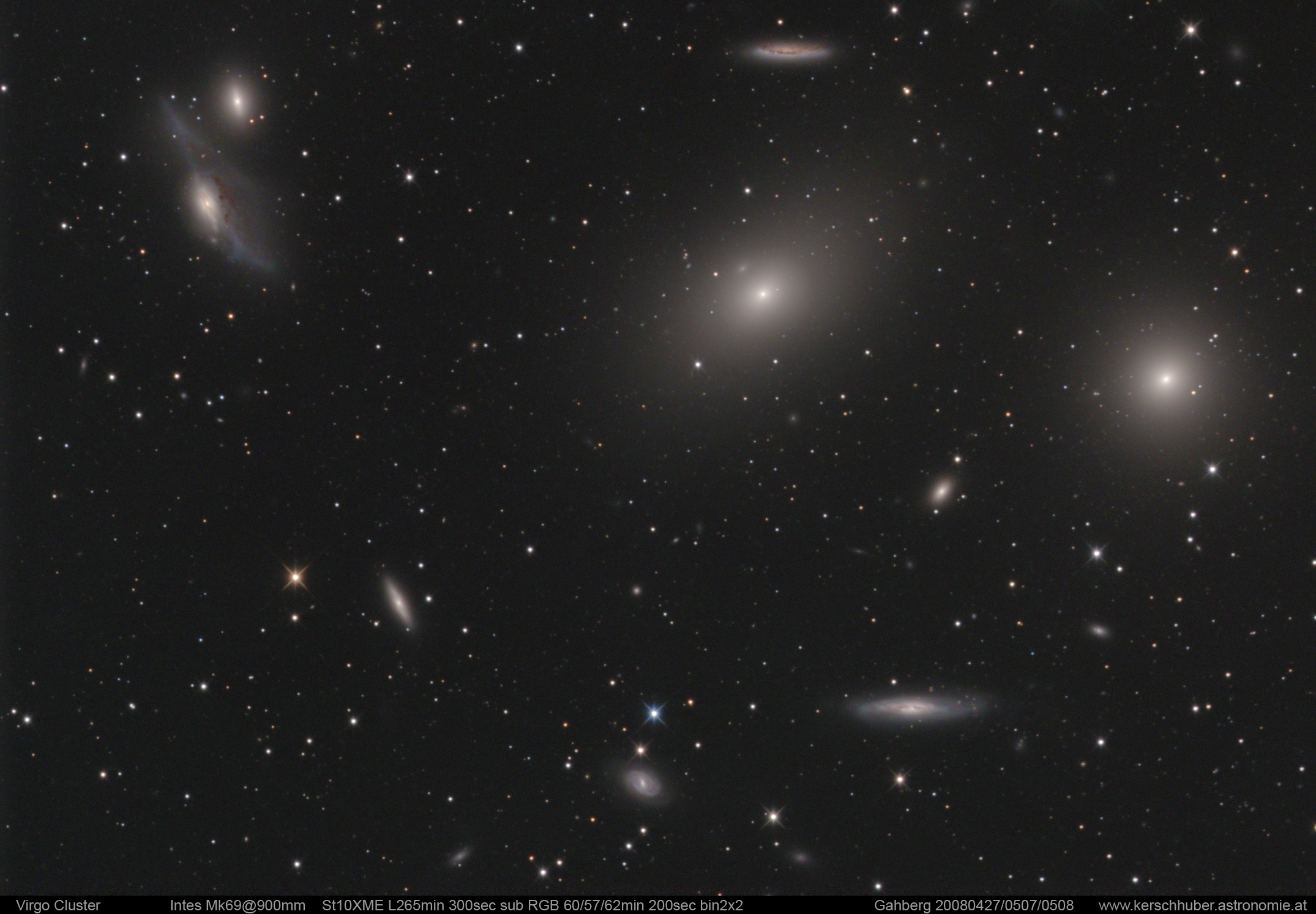 In the Heart of the Virgo Cluster In the Heart of the Virgo Cluster
Credit & Copyright: Günter Kerschhuber (Gahberg Observatory) Explanation: The Virgo Cluster of Galaxies is the closest cluster of galaxies to our Milky Way Galaxy. The Virgo Cluster is so close that it spans more than 5 degrees on the sky - about 10 times the angle made by a full Moon. With its heart lying about 70 million light years distant, the Virgo Cluster is the nearest cluster of galaxies, contains over 2,000 galaxies, and has a noticeable gravitational pull on the galaxies of the Local Group of Galaxies surrounding our Milky Way Galaxy. The cluster contains not only galaxies filled with stars but also gas so hot it glows in X-rays. Motions of galaxies in and around clusters indicate that they contain more dark matter than any visible matter we can see. Pictured above, the heart of the Virgo Cluster includes bright Messier galaxies such as Markarian's Eyes on the upper left, M86 just to the upper right of center, M84 on the far right, as well as spiral galaxy NGC 4388 at the bottom right.
|
|
|
|
Post by Jack on Jul 9, 2008 16:17:02 GMT
Source: NASA Planets and Fire by Moonlight Planets and Fire by Moonlight
Credit & Copyright: Dmitrii ZagorodnovExplanation: On July 5th, wandering planets, bright stars, and a young crescent Moon graced western skies after sunset. Arrayed along the solar system's ecliptic plane, the three celestial beacons forming this skyscape's eye-catching line-up with the Moon are Saturn (upper left), then Mars, and finally Regulus, alpha star of the constellation Leo. Of course planet Earth itself lies in the foreground, a scene dominated by the city lights of Santa Barbara, California. The smoky haze hanging over the city is from threatening wild fires still burning along the hill at the right. On Thursday evening, Saturn and Mars can be seen in a much closer pairing or conjunction, separated by only about 3/4 degree on the sky.
|
|
|
|
Post by Jack on Jul 11, 2008 19:19:01 GMT
Source: NASA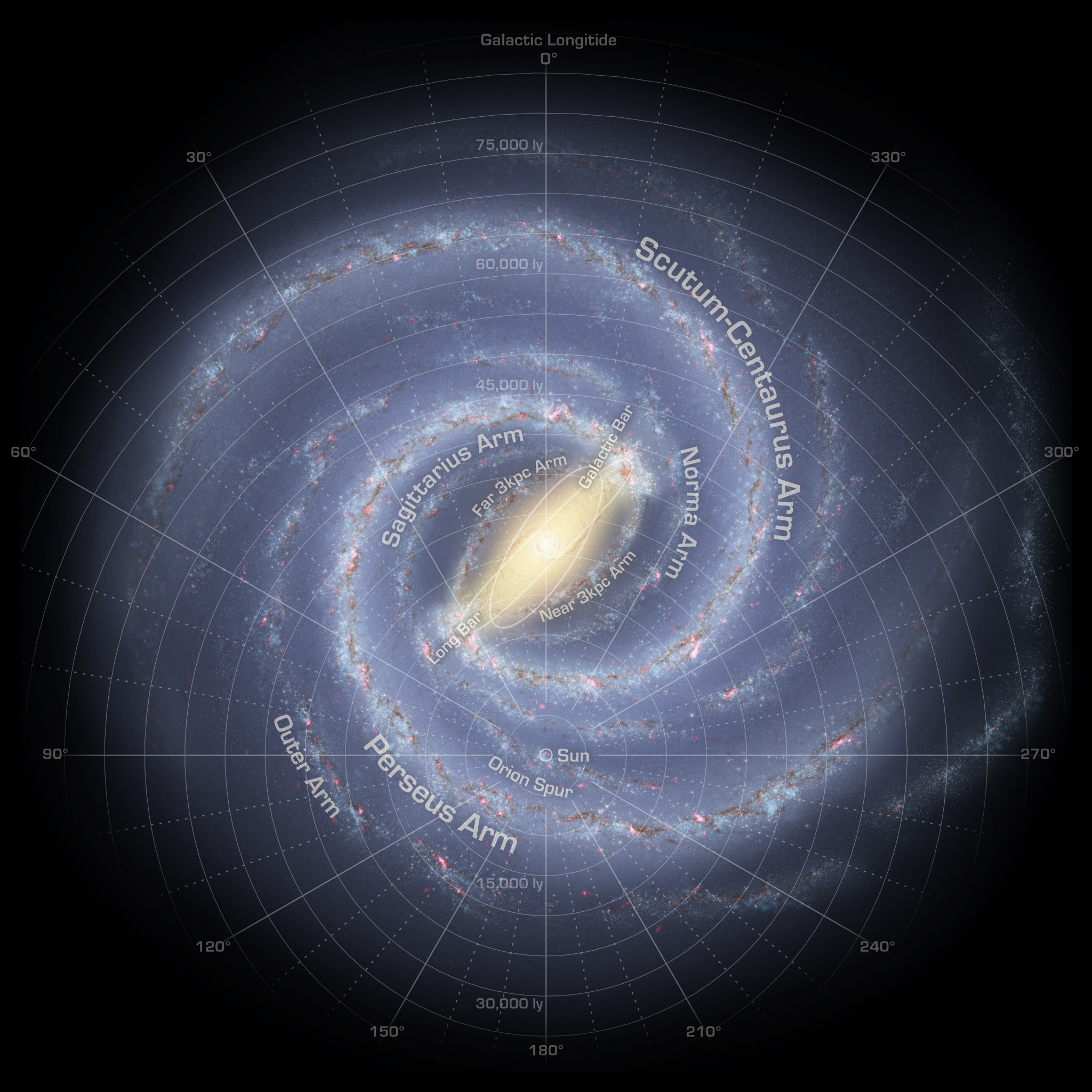 The Far 3kpc Arm The Far 3kpc Arm
Illustration Credit: R. Hurt (SSC), JPL-Caltech, NASAExplanation: A major discovery was lurking in the data. By accident, while preparing a talk on the Galaxy's spiral arms for a meeting of the American Astronomical Society, Tom Dame (Harvard-Smithsonian CfA) found it - a new spiral arm in the Milky Way. The arm is labeled in this illustration as the Far 3kpc Arm, located at a distance of 3 kpc (kiloparsecs) or about 10,000 light-years from the galactic center, on the opposite side from the Sun. Along with the Near 3kpc Arm whose presence was known since the mid 1950s, the counterpart inner arms now establish that the galaxy has a simple symmetry. The arms are defined by shocked interstellar gas flowing along both sides of the Milky Way's central bar. Dame and his collaborator Patrick Thaddeus recorded the presence of both inner spiral arms in their radio data tracking emission from carbon monoxide molecules along the galactic plane. How much star formation goes on in the counterpart arms? Despite this depiction of stars and star forming regions along the arms, the last attempt to search for star formation in the Near 3kpc Arm was in 1980 and didn't turn up any. The discovery of the Far 3kpc Arm has renewed interest in this and other questions about the center of the Milky Way.
|
|